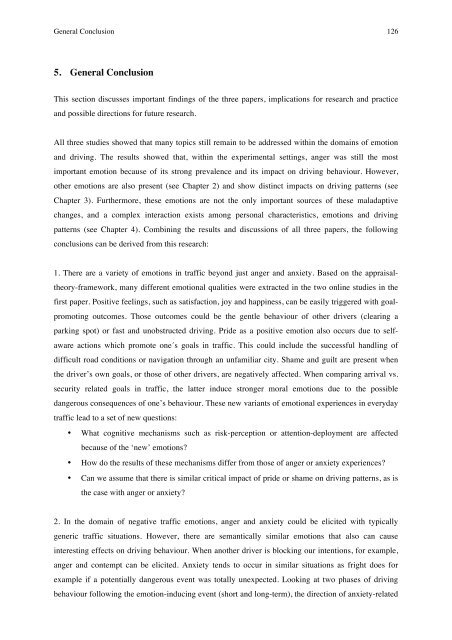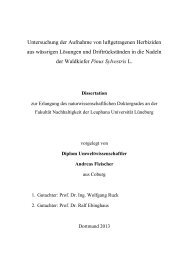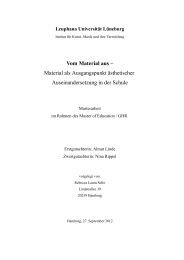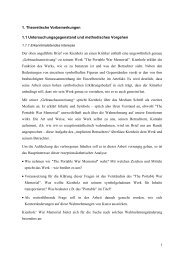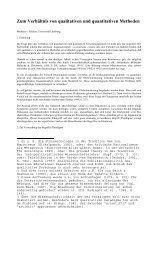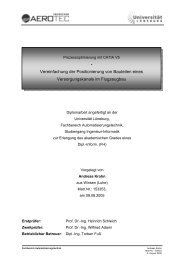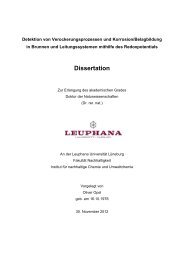Determinants of Emotional Experiences in Traffic Situations ... - OPUS
Determinants of Emotional Experiences in Traffic Situations ... - OPUS
Determinants of Emotional Experiences in Traffic Situations ... - OPUS
Create successful ePaper yourself
Turn your PDF publications into a flip-book with our unique Google optimized e-Paper software.
General Conclusion 126!<br />
5. General Conclusion<br />
This section discusses important f<strong>in</strong>d<strong>in</strong>gs <strong>of</strong> the three papers, implications for research and practice<br />
and possible directions for future research.<br />
All three studies showed that many topics still rema<strong>in</strong> to be addressed with<strong>in</strong> the doma<strong>in</strong>s <strong>of</strong> emotion<br />
and driv<strong>in</strong>g. The results showed that, with<strong>in</strong> the experimental sett<strong>in</strong>gs, anger was still the most<br />
important emotion because <strong>of</strong> its strong prevalence and its impact on driv<strong>in</strong>g behaviour. However,<br />
other emotions are also present (see Chapter 2) and show dist<strong>in</strong>ct impacts on driv<strong>in</strong>g patterns (see<br />
Chapter 3). Furthermore, these emotions are not the only important sources <strong>of</strong> these maladaptive<br />
changes, and a complex <strong>in</strong>teraction exists among personal characteristics, emotions and driv<strong>in</strong>g<br />
patterns (see Chapter 4). Comb<strong>in</strong><strong>in</strong>g the results and discussions <strong>of</strong> all three papers, the follow<strong>in</strong>g<br />
conclusions can be derived from this research:<br />
1. There are a variety <strong>of</strong> emotions <strong>in</strong> traffic beyond just anger and anxiety. Based on the appraisaltheory-framework,<br />
many different emotional qualities were extracted <strong>in</strong> the two onl<strong>in</strong>e studies <strong>in</strong> the<br />
first paper. Positive feel<strong>in</strong>gs, such as satisfaction, joy and happ<strong>in</strong>ess, can be easily triggered with goalpromot<strong>in</strong>g<br />
outcomes. Those outcomes could be the gentle behaviour <strong>of</strong> other drivers (clear<strong>in</strong>g a<br />
park<strong>in</strong>g spot) or fast and unobstructed driv<strong>in</strong>g. Pride as a positive emotion also occurs due to selfaware<br />
actions which promote one´s goals <strong>in</strong> traffic. This could <strong>in</strong>clude the successful handl<strong>in</strong>g <strong>of</strong><br />
difficult road conditions or navigation through an unfamiliar city. Shame and guilt are present when<br />
the driver’s own goals, or those <strong>of</strong> other drivers, are negatively affected. When compar<strong>in</strong>g arrival vs.<br />
security related goals <strong>in</strong> traffic, the latter <strong>in</strong>duce stronger moral emotions due to the possible<br />
dangerous consequences <strong>of</strong> one’s behaviour. These new variants <strong>of</strong> emotional experiences <strong>in</strong> everyday<br />
traffic lead to a set <strong>of</strong> new questions:<br />
• What cognitive mechanisms such as risk-perception or attention-deployment are affected<br />
because <strong>of</strong> the ‘new’ emotions?<br />
• How do the results <strong>of</strong> these mechanisms differ from those <strong>of</strong> anger or anxiety experiences?<br />
• Can we assume that there is similar critical impact <strong>of</strong> pride or shame on driv<strong>in</strong>g patterns, as is<br />
the case with anger or anxiety?<br />
2. In the doma<strong>in</strong> <strong>of</strong> negative traffic emotions, anger and anxiety could be elicited with typically<br />
generic traffic situations. However, there are semantically similar emotions that also can cause<br />
<strong>in</strong>terest<strong>in</strong>g effects on driv<strong>in</strong>g behaviour. When another driver is block<strong>in</strong>g our <strong>in</strong>tentions, for example,<br />
anger and contempt can be elicited. Anxiety tends to occur <strong>in</strong> similar situations as fright does for<br />
example if a potentially dangerous event was totally unexpected. Look<strong>in</strong>g at two phases <strong>of</strong> driv<strong>in</strong>g<br />
behaviour follow<strong>in</strong>g the emotion-<strong>in</strong>duc<strong>in</strong>g event (short and long-term), the direction <strong>of</strong> anxiety-related


